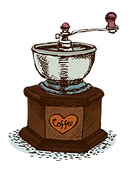


roaster
All Grounds For Thought coffee is hand-roasted in small batches at our downtown Roaster, located less than one block from our Coffee Shop.
By roasting award winning coffee onsite five days a week we provide the perfect cup of fresh coffee for your home, office or special event.
For wholesale information please contact Kelly at: kelly@groundsforthought.com
Video from WGTE Public Media
Body
The physical properties of the beverage resulting in the tactile sensation in the mouth during and after drinking coffee. Body is used to describe the feel of a drink corresponding to a certain consistency. Body or mouth feel is the sense of heaviness, richness, and thickness on the tongue when you swish the coffee around your mouth. The coffee is not actually heavy it just tastes that way. Orange juice has a heavy body and water has a light clean body.
Acidity
The lively, palate cleansing property which is characteristic of all highgrown coffees is acidity. Most of the world's finer coffees have considerable acidity. This is responsible for a coffee’s brightness, not to be confused with “sourness” or “bitterness”. It is a favorable quality, a pleasant “sparkle” or “tang” on the tongue. For example, orange juice has a lot of acidity which enhances its tangy flavor and gives it a brightness that lingers on the tongue. For those customers looking for a low acidity coffee because of stomach irritation, you could recommend that milk or cream will neutralize acidity to some degree.

Coffee Descriptions

Roasting style
Roasting the coffee beans is done by dropping the beans into a solid high carbon steel drum that rotates inside. The beans are roasted by a combination of hot air being drawn through the chamber and the drum, which is heated as well. The temperature and amount of time roasting effect the final flavor of each batch of beans. Much like your favorite chocolate chip cookie might be crispy or gooey depending on amount of time baked the time roasted will affect the outcome of the bean. A darker roast may accentuate the sweetness of a bean where a lighter roast might highlight the nutty flavor of a costa rica. The longer and higher temperature at which you roast will caramelize the sugars and add a smoky flavor to the final cup. Very similar to how roasting vegetables at a high temperature will caramelize the sugars and add a smoky hint to the veggie. A darker roast can sometimes overwhelm the flavors and nuances of individual origins, leaving you with sweet and smoky as the defining characteristics.

A roaster can bring out the best of each bean’s particular character in a consistent manner that allows you to drink your favorite Guatemala Antigua for weeks on end and it tastes the same from week to week.
Keeping your beans fresh is the next favor you can do for yourself. Coffee is an agricultural product with a shelf life. Just as a tomato is only good for a set amount of time after you buy it, so too is coffee. It will depend on your palate, but most people will be able to detect some staleness and loss of flavor ten days after bringing their coffee home.
Grinding right before brewing will also preserve the freshness. Once you grind your coffee, you are exposing more surface to the air which causes the oils responsible for the flavor and aroma of coffee to evaporate. It is best to buy often, grind before brewing, drink daily and store your coffee in a dark cool cubboard in an air tight container. The freezer is not recommended as every time you open the freezer door moisture condenses on the grounds adding freezer flavor and accelerating the staling.
Finish
The aftertaste of the coffee left in the mouth once it's swallowed. The flavor that lingers in the mouth.
Grinding and Brewing
Grind, brewing process and water are the next variables that will determine how your cup of coffee tastes. The finer the grind, the more of the coffee’s surface is exposed to water thus producing a higher water to coffee ratio resulting in a stronger brew.
Coarse
This is our coarsest option. This setting is used for French presses or cold brew.
Percolator There are two options. Stove top percolator or an electric percolator.
Automatic drip
The setting we use for coffee at the shop. This is appropriate for any gravity fed brewing method. Good for Keurig.
Filter
This grind would be recommended for a pour over filter. This method allows the water to be heated to the desired temperature and then manually poured over the coffee grounds. Also good for Keurig.
Espresso
Two settings are available, fine and finer. This grind is suitable for stove top espresso makers or home espresso machines.
Turkish
Finest grind available. This is for a stove top method that boils the coffee in a small Turkish pot for a very strong cup of coffee.

origin of the coffee
It may not be true for all coffee coming from a region, but can be used to help categorize flavor profiles.
South and Central America
Coffees from these regions tend to have well balanced acidity, caramel or nutty flavors, and a medium body.
Indonesian
Coffees from this region tend to have a heavier body due to lower acidity and can often be characterized by spicy, chocolate or earthy notes.
African
Coffees from African tend to have bright flavors and winey or fruity notes due to higher acidity.

